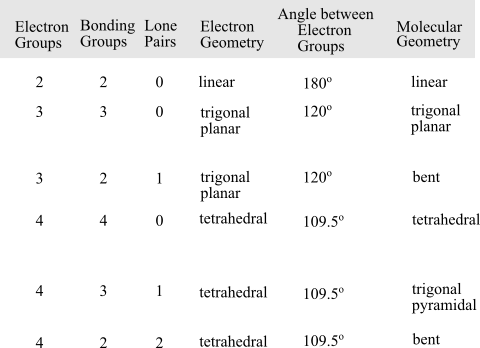
Interpretation: The formulas and space filling models of the given molecules are to be examined. The correctness of each structure is to be checked. The correct structure is to be sketched for incorrect structures.
Concept Introduction: A Lewis structure is used to represent the valence electrons and the bonds present in a molecule.
Dots in the Lewis structure represent the valence electrons.
Total number of electrons for Lewis structure can be calculated by summing the valence electrons of each atom in the molecule.
Once a Lewis structure is drawn, it is possible to identify the shape of the molecule using the VSEPR theory.
VSEPR stand for Valence Shell Electron Pair repulsion theory. It uses chemical formula, number of bonds and lone pairs to predict the shape of molecules.
The geometry of a molecule or a polyatomic ion is determined on the basis of the total number of electron groups, the number of bonding groups and the number of lone pairs. To determine the geometry of the molecule, follow the following table:

Want to see the full answer?
Check out a sample textbook solution
Chapter 10 Solutions
Introductory Chemistry, Books a la Carte Plus MasteringChemistry with eText -- Access Card Package (5th Edition)
- Draw the mechanism of the reaction.arrow_forward9. Draw all of the possible Monochlorination Products that would Result From the Free Radical Chlormation OF 23,4-TRIMethyl Pentane b. Calculate the To Yield For the major • Product given the Following Relative Restritus For 1° 2° and 30 Hydrogens toward Free Radical Chloration 5.0: 38 : 1 30 2° 1° C. what would be the major product in the Free Radical brominator Of the Same Molecule. Explain your Reasoning.arrow_forwardWhat is the complete reaction mechanism for the chlorination of Ethane, C2H6?arrow_forward
- A 13C NMR spectrum is shown for a molecule with the molecular formula of C6H100. Draw the structure that best fits this data. 220 200 180 160 140 120100 80 60 40 20 Drawingarrow_forwardPlease help me figure out the blan areas with step by step calculations.arrow_forwardneeding help draw all of the possible monochlorination products that would result from the free radical chlorination of 2,3,4-trimethylpentanearrow_forward
- HAND DRAWarrow_forwardBased on the 1H NMR, 13C NMR, DEPT 135 NMR and DEPT 90 NMR, provide a reasoning step and arrive at the final structure of an unknown organic compound containing 7 carbons. Dept 135 shows peak to be positive at 128.62 and 13.63 Dept 135 shows peak to be negative at 130.28, 64.32, 30.62 and 19.10. Provide assignment for the provided structurearrow_forwardO Predict the 'H NMR integration ratio for the following structure. IV I. 3 H A II. 1 H III. 2 H IV. 3 H I. 3 H B II. O H III. 2 H IV. 3 H I. 3 H C II. 2 H III. 2 Harrow_forward
 Chemistry: The Molecular ScienceChemistryISBN:9781285199047Author:John W. Moore, Conrad L. StanitskiPublisher:Cengage Learning
Chemistry: The Molecular ScienceChemistryISBN:9781285199047Author:John W. Moore, Conrad L. StanitskiPublisher:Cengage Learning Chemistry: Principles and PracticeChemistryISBN:9780534420123Author:Daniel L. Reger, Scott R. Goode, David W. Ball, Edward MercerPublisher:Cengage Learning
Chemistry: Principles and PracticeChemistryISBN:9780534420123Author:Daniel L. Reger, Scott R. Goode, David W. Ball, Edward MercerPublisher:Cengage Learning

